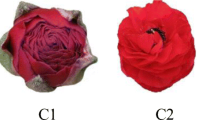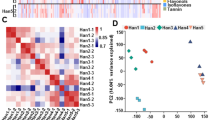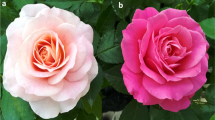Abstract
Flower color is a trait that affects the ornamental value of a plant. Camellia sasanqua is a horticultural plant with rich flower color, but little is known about the regulatory mechanism of color diversity in this plant. Here, the anthocyanin profile of 20 C. sasanqua cultivars revealed and quantified 11 anthocyanin derivatives (five delphinidin-based and six cyanidin-based anthocyanins) for the first time. Cyanidin-3-O-(6-O-(E)-p-coumaroyl)-glucoside was the main contributor to flower base color, and the accumulation of cyanidin and delphinidin derivatives differed in the petals. To further explore the molecular mechanism of color divergence, a transcriptome analysis was performed using C. sasanqua cultivars ‘YingYueYe’, ‘WanXia’, ‘XueYueHua’, and’XiaoMeiGui’. The co-expression network related to differences in delphinidin and cyanidin derivatives accumulation was identified. Eleven candidate genes encoding key enzymes (e.g., F3H, F3′H, and ANS) were involved in anthocyanin biosynthesis. Moreover, 27 transcription factors were screened as regulators of the two types of accumulating anthocyanins. The association was suggested by correlation analysis between the expression levels of the candidate genes and the different camellia cultivars. We concluded that cyanidin and delphinidin derivatives are the major drivers of color diversity in C. sasanqua. This finding provides valuable resources for the study of flower color in C. sasanqua and lays a foundation for genetic modification of anthocyanin biosynthesis.








Similar content being viewed by others
Data availability
The datasets generated and/or analyzed during this study are included in this article, its supplementary information files, or the [NCBI] repository with Accession number: PRJNA799897 [https://www.ncbi.nlm.nih.gov/sra/PRJNA799897].
References
An JP, Qu FJ, Yao JF, Wang XN, You CX, Wang XF, Hao YJ (2017) The bZIP transcription factor MdHY5 regulates anthocyanin accumulation and nitrate assimilation in apple. Horticult Res 4:17023. https://doi.org/10.1038/hortres.2017.23
An J, Wang X, Zhang X, Bi S, You C, Hao Y (2019) MdBBX22 regulates UV-B-induced anthocyanin biosynthesis through regulating the function of MdHY5 and is targeted by MdBT2 for 26S proteasome-mediated degradation. Plant Biotechnol J 17:2231–2233. https://doi.org/10.1111/pbi.13196
Anders S, Huber W (2010) Differential expression analysis for sequence count data. Genome Biol 11:R106. https://doi.org/10.1186/gb-2010-11-10-r106
Ashburner M, Ball CA, Blake JA, Botstein D, Butler H, Cherry JM, Davis AP, Dolinski K, Dwight SS, Eppig JT, Harris MA, Hill DP, Issel-Tarver L, Kasarskis A, Lewis S, Matese JC, Richardson JE, Ringwald M, Rubin GM, Sherlock G (2000) Gene ontology: tool for the unification of biology. The Gene Ontology Consortium. Nat Genet 25:25–29. https://doi.org/10.1038/75556
Brugliera F, Tanaka Y, Mason J (2003) Flavonoid 30,50-hydroxylase gene sequences and uses therefor. World Intellectual Property Organization Publ.of the Int. Appl. with Int. search report WO2003AU01111
Brugliera F, Tao GQ, Tems U, Kalc G, Mouradova E, Price K, Stevenson K, Nakamura N, Stacey I, Katsumoto Y, Tanaka Y, Mason JG (2013) Violet/blue chrysanthemums—metabolic engineering of the anthocyanin biosynthetic pathway results in novel petal colors. Plant Cell Physiol 54:1696–1710. https://doi.org/10.1093/pcp/pct110
De Rosso VV, Mercadante AZ (2007) The high ascorbic acid content is the main cause of the low stability of anthocyanin extracts from acerola. Food Chem 103:935–943. https://doi.org/10.1016/j.foodchem.2006.09.047
Deng Y, Li J, Wu S, Zhu Y, Chen Y, He F (2006) Integrated NR database in protein annotation system and its localization. Comput Eng 32:71–74
Duan S, Wang J, Gao C (2018) Functional characterization of a heterologously expressed brassica napus wrky41-1 transcription factor in regulating anthocyanin biosynthesis in Arabidopsis thaliana. Plant Sci 268:47–53. https://doi.org/10.1016/j.plantsci.2017.12.010
Fan M, Yang K, Zhou R, Liu Q, Guo X, Sun Y (2021) Temporal transcriptome profiling reveals candidate genes involved in cold acclimation of Camellia japonica (Naidong). Plant Physiol Biochem 167:795–805. https://doi.org/10.1016/j.plaphy.2021.09.006
Fan M, Zhang Y, Yang M, Wu S, Yin H, Li J, Li X (2022) Transcriptomic and chemical analyses reveal the hub regulators of flower color variation from Camellia japonica bud sport. Horticulturae 8:129. https://doi.org/10.3390/horticulturae8020129
Faraco M, Spelt C, Bliek M, Verweij W, Hoshino A, Espen L, Prinsi B, Jaarsma R, Tarhan E, de Boer AH, Di Sansebastiano GP, Koes R, Quattrocchio FM (2014) Hyperacidification of vacuoles by the combined action of two different P-ATPases in the tonoplast determines flower color. Cell Rep 6(1):32–43. https://doi.org/10.1016/j.celrep.2013.12.009
Finn RD, Bateman A, Clements J, Coggill P, Eberhardt RY, Eddy SR, Heger A, Hetherington K, Holm L, Mistry J, Sonnhammer EL, Tate J, Punta M (2014) Pfam: the protein families database. Nucleic Acids Res 42:D222–D230. https://doi.org/10.1093/nar/gkt1223
Fu M, Yang X, Zheng J, Wang L, Yang X, Tu Y, Ye J, Zhang W, Liao Y, Cheng S, Xu F (2021) Unraveling the regulatory mechanism of color diversity in Camellia japonica petals by integrative transcriptome and metabolome analysis. Front Plant Sci 12:685136. https://doi.org/10.3389/fpls.2021.685136
Guo LP, Wang YJ, Teixeira da Silva JA, Fan YM, Yu XN (2019) Transcriptome and chemical analysis reveal putative genes involved in flower color change in Paeonia ‘Coral Sunset.’ Plant Physiol Biochem 138:130–139. https://doi.org/10.1016/j.plaphy.2019.02.025
Han M-L, Yin J, Zhao Y-H, Sun X-W, Meng J-X, Zhou J, Shen T, Li H-H, Zhang F (2020) How the color fades from Malus halliana flowers: transcriptome sequencing and DNA methylation analysis. Front Plant Sci 11:576054. https://doi.org/10.3389/fpls.2020.576054
Han X, Luo Y, Lin J, Wu H, Sun H, Zhou L, Chen S, Guan Z, Fang W, Zhang F, Chen F, Jiang J (2021) Generation of purple-violet chrysanthemums via anthocyanin B-ring hydroxylation and glucosylation introduced from Osteospermum hybrid F3’5’H and Clitoria ternatea A3’5’GT. Ornam Plant Res 1:4. https://doi.org/10.48130/OPR2021-0004
Huang B, Rong H, Ye Y, Ni Z, Xu M, Zhang W, Xu LA (2020) Transcriptomic analysis of flower color variation in the ornamental crabapple (Malus spp.) half-sib family through Illumina and PacBio Sequel sequencing. Plant Physiol Biochem 149:27–35. https://doi.org/10.1016/j.plaphy.2020.01.033
Ji XH, Zhang R, Wang N, Yang L, Chen X (2015) Transcriptome profiling reveals auxin suppressed anthocyanin biosynthesis in red-fleshed apple callus (Malus sieversii f niedzwetzkyana). Plant Cell Tissue Organ Cult 123:389–404. https://doi.org/10.1007/s11240-015-0843-y
Jiang T, Zhang M, Wen C, Xie X, Tian W, Wen S, Lu R, Liu L (2020) Integrated metabolomic and transcriptomic analysis of the anthocyanin regulatory networks in Salvia miltiorrhiza Bge flowers. BMC Plant Biol 20:349. https://doi.org/10.1186/s12870-020-02553-7
Kanehisa M, Goto S, Kawashima S, Okuno Y, Hattori M (2004) The KEGG resource for deciphering the genome. Nucleic Acids Res 32:D277–D280. https://doi.org/10.1093/nar/gkh063
Lescot M, Déhais P, Thijs G, Marchal K, Moreau Y, Van de Peer Y, Rouzé P, Rombauts S (2002) Plant CARE, a database of plant cis-acting regulatory elements and a portal to tools for in silico analysis of promoter sequences. Nucleic Acids Res 30:325–327. https://doi.org/10.1093/nar/30.1.325
Li JB, Hashimoto F, Shimizu K, Sakata Y (2008) Anthocyanins from the red flowers of Camellia saluenensis Stapf ex Bean. J Jpn Soc Horticult Sci 77:75–79. https://doi.org/10.2503/jjsshs1.77.75
Li JB, Hashimoto F, Shimizu K, Sakata Y (2009) A new acylated anthocyan inform the red flowers of Camellia hongkongensis and characterization of anthocyanins in the Section Camellia species. J Plant Ecol 51:545–552. https://doi.org/10.1111/j.1744-7909.2009.00828.x
Li Y, Im Kim J, Pysh L, Chapple C (2015) Four isoforms of Arabidopsis 4-Coumarate: CoA Ligase have overlapping yet distinct roles in phenylpropanoid metabolism. Plant Physiol 169:2409–2421. https://doi.org/10.1104/pp.15.00838
Li X, Wang J, Yin H, Fan Z, Li J (2019a) Variation of flower colors and their relationships with anthocyanins in cultivars of camellia japonica. J Ecol Rural Environ 35:1307–1313
Li H, Liu J, Pei T, Bai Z, Han R, Liang Z (2019b) Overexpression of SmANS enhances anthocyanin accumulation and alters phenolic acids content in Salvia miltiorrhiza and Salvia miltiorrhiza Bge f alba Plantlets. Int J Mol Med 20:2225. https://doi.org/10.3390/ijms20092225
Lin P, Wang K, Wang Y et al (2022) The genome of oil-Camellia and population genomics analysis provide insights into seed oil domestication. Genome Biol 23:14. https://doi.org/10.1186/s13059-021-02599-2
Liu L, Zhang L, Wang S, Niu X (2016) Analysis of anthocyanins andflavonols in the petals of 10 Rhododendron species from the sygera mountains in southeast tibet. Plant Physiol Biochem 104:250–256. https://doi.org/10.1016/j.plaphy.2016.03.036
Liu YJ, Li M, Li T, Chen YJ, Zhang LJ, Zhao GF, Zhuang GH, Zhao WY, Gao LP, Xia T (2020) Airborne fungus-induced biosynthesis of anthocyanins in Arabidopsis thaliana via jasmonic acid and salicylic acid signaling. Plant Sci 300:110635. https://doi.org/10.1016/j.plantsci.2020.110635
Luo P, Ning G, Wang Z, Shen Y, Jin H, Li P, Huang S, Zhao J, Bao M (2016) Disequilibrium of flavonol synthase and dihydroflavonol-4-reductase expression associated tightly to white vs red color flower formation in plants. Front Plant Sci 6:1257. https://doi.org/10.3389/fpls.2015.01257
Maier A, Schrader A, Kokkelink L, Falke C, Welter B, Iniesto E, Rubio V, Uhrig JF, Hülskamp M, Hoecker U (2013) Light and the E3 ubiquitin ligase COP1/SPA control the protein stability of the MYB transcription factors PAP1 and PAP2 involved in anthocyanin accumulation in Arabidopsis. Plant J 74:638–651. https://doi.org/10.1111/tpj.12153
Martins AE, Camargo MGG, Morellato LPC (2021) Flowering phenology and the influence of seasonality in flower conspicuousness for bees. Front Plant Sci 11:2301. https://doi.org/10.3389/fpls.2020.594538
Noda N, Aida R, Kishimoto S, Ishiguro K, Fukuchi-Mizutani M, Tanaka Y, Ohmiya A (2013) Genetic engineering of novel bluer-colored chrysanthemums produced by accumulation of delphinidin-based anthocyanins. Plant Cell Physiol 54:1684–1695. https://doi.org/10.1093/pcp/pct111
Qin J, Zhao C, Wang S, Gao N, Wang X, Na X, Wang X, Bi Y (2021) PIF4-PAP1 interaction affects MYB-bHLH-WD40 complex formation and anthocyanin accumulation in Arabidopsis. J Plant Physiol 268:153558. https://doi.org/10.1016/j.jplph.2021.153558
Rao MJ, Ahmed U, Ahmed MH, Duan M, Wang J, Wang Y, Wang L (2021) Comparison and quantification of metabolites and their antioxidant activities in young and mature leaves of sugarcane. ACS Food Sci Technol 1:362–373. https://doi.org/10.1021/acsfoodscitech.0c00133
Rausher MD (2006) Chapter 7: The evolution of flavonoids and their genes. In: Grotewold E (ed) The science of flavonoids. Springer, New York, pp 175–211
Seitz C, Ameres S, Forkmann G (2007) Identification of the molecular basis for the functional difference between flavonoid 3′-hydroxylase and flavonoid 3′,5′-hydroxylase. FEBS Lett 581:3429–3434. https://doi.org/10.1016/j.febslet.2007.06.045
Tanaka Y, Brugliera F (2013) Flower colour and cytochromes P450. Philos Trans R Soc Lond B 368:432. https://doi.org/10.1098/rstb.2012.0432
Tang B, Li L, Hu Z, Chen Y, Tan T, Jia Y, Xie Q, Chen G (2020) Anthocyanin accumulation and transcriptional regulation of anthocyanin biosynthesis in purple pepper. J Agric Food Chem 68:12152–12163. https://doi.org/10.1021/acs.jafc.0c02460
Wang LS, Shiraishi A, Hashimoto F, Aoki N, Shimizu K, Sakata Y (2001) Analysis of petal anthocyanins to investigate flower coloration of Zhongyuan (Chinese) and Daikon Island (Japanese) tree peony cultivars. J Plant Res 114:33–43. https://doi.org/10.1007/PL00013966
Wang Z, Du H, Zhai R, Song L, Ma F, Xu L (2017) Transcriptome analysis reveals candidate genes related to color fading of ‘red bartlett’ (Pyrus communis L.). Front Plant Sci 8:455. https://doi.org/10.3389/fpls.2017.00455
Xue L, Wang Z, Zhang W, Li Y, Wang J, Lei J (2016) Flower pigment inheritance and anthocyanin characterization of hybrids from pink-flowered and white-flowered strawberry. Sci Hortic 200:143–150. https://doi.org/10.1016/j.scienta.2016.01.020
Yang B, He S, Liu Y, Liu B, Ju Y, Kang D, Sun X, Fang Y (2020) Transcriptomics integrated with metabolomics reveals the effect of regulated deficit irrigation on anthocyanin biosynthesis in Cabernet Sauvignon grape berries. Food Chem 314:126170. https://doi.org/10.1016/j.foodchem.2020.126170
Yoshida K, Mori M, Kondo T (2009) Blue flower color development by anthocyanins: from chemical structure to cell physiology. Nat Prod Rep 26:884–915. https://doi.org/10.1039/b800165k
Zhang Y, Chen G, Dong T, Pan Y, Zhao Z, Tian S, Hu Z (2014) Anthocyanin accumulation and transcriptional regulation of anthocyanin biosynthesis in purple bok choy (Brassica rapa var chinensis). J Agric Food Chem 62:12366–12376. https://doi.org/10.1021/jf503453e
Zhao J (2015) Flavonoid transport mechanisms: how to go, and with whom. Trends Plant Sci 20(9):576–585
Zhao J, Dixon RA (2010) The “ins” and “outs” of flavonoid transport. Trends Plant Sci 15(2):72–80
Zhao DQ, Wei MR, Liu D, Tao J (2016) Anatomical and biochemical analysis reveal the role of anthocyanins inflower coloration of herbaceous peony. Plant Physiol Biochem 102:97–106. https://doi.org/10.1016/j.plaphy.2016.02.023
Zheng Y, Jiao C, Sun H, Rosli HG, Pombo MA, Zhang P, Banf M, Dai X, Martin GB, Giovannoni JJ, Zhao PX, Rhee SY, Fei Z (2016) iTAK: a program for genome-wide prediction and classification of plant transcription factors, transcriptional regulators, and protein kinases. Mol Plant 9:1667–1670. https://doi.org/10.1016/j.molp.2016.09.014
Zhou H, Kui LW, Wang H, Gu C, Dare AP, Espley RV, He H, Allan AC, Han Y (2015) Molecular genetics of blood-fleshed peach reveals activation of anthocyanin biosynthesis by NAC transcription factors. Plant J 82:105–121. https://doi.org/10.1111/tpj.12792
Acknowledgements
The authors are grateful to the editors and referees.
Funding
This work was supported by National Key R&D Program of China [Grant No. 2020YFD1000500] and Zhejiang Basic and Public Welfare Research Program [Grant No. LGN20C160006].
Author information
Authors and Affiliations
Contributions
MF conducted the data analysis and wrote the manuscript; XL and HY conceived and designed the experiments; YZ, WL and MY performed the experiments; SW and JL contributed plant material. All authors have read and agreed to the published version of the manuscript.
Corresponding author
Ethics declarations
Conflict of interest
The authors declare no conflicts of interest.
Additional information
Publisher's Note
Springer Nature remains neutral with regard to jurisdictional claims in published maps and institutional affiliations.
Supplementary Information
Below is the link to the electronic supplementary material.
Supplementary file1 (PDF 2694 KB)
Supplementary Fig S1. The co-elution profile with the standard substance (Cy3G).
Supplementary file2 (PDF 1250 KB)
Supplementary Fig S2. The correlation analysis of the sequencing data.
Supplementary file3 (XLSX 13 KB)
Supplementary Table S1. The raw chroma value data.
Supplementary file4 (XLSX 20 KB)
Supplementary Table S2. The LC-MS anthocyanin data.
Supplementary file5 (XLSX 11 KB)
Supplementary Table S3. Summary of sequencing quality.
Supplementary file6 (XLSX 18 KB)
Supplementary Table S4. Identified genes related to the anthocyanin metabolic pathway.
Supplementary file7 (XLSX 266 KB)
Supplementary Table S5. The GO enrichment analysis of the co-expression modules.
Supplementary file8 (XLSX 40 KB)
Supplementary Table S6. The KEGG enrichment analysis of the co-expression modules.
Supplementary file9 (XLSX 15 KB)
Supplementary Table S7. The identified TFs in the co-expression modules.
Supplementary file10 (XLSX 11 KB)
Supplementary Table S8. The RT-qPCR primers.
Rights and permissions
Springer Nature or its licensor (e.g. a society or other partner) holds exclusive rights to this article under a publishing agreement with the author(s) or other rightsholder(s); author self-archiving of the accepted manuscript version of this article is solely governed by the terms of such publishing agreement and applicable law.
About this article
Cite this article
Fan, M., Li, X., Zhang, Y. et al. Novel insight into anthocyanin metabolism and molecular characterization of its key regulators in Camellia sasanqua. Plant Mol Biol 111, 249–262 (2023). https://doi.org/10.1007/s11103-022-01324-2
Received:
Accepted:
Published:
Issue Date:
DOI: https://doi.org/10.1007/s11103-022-01324-2




